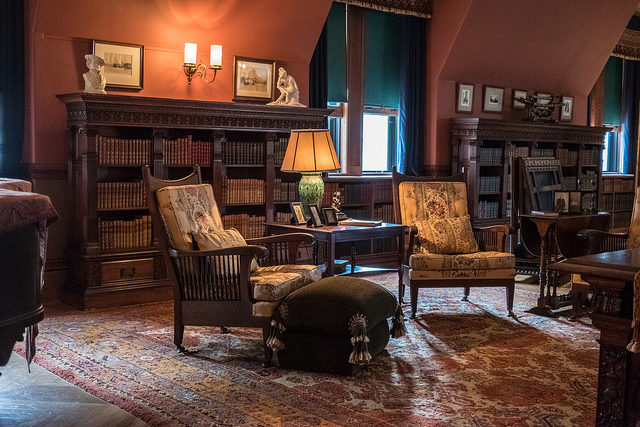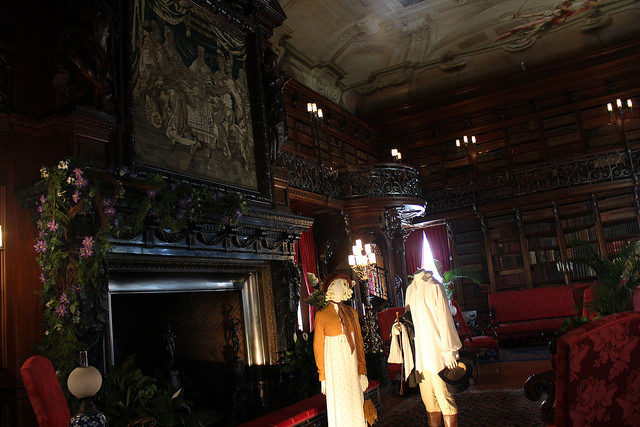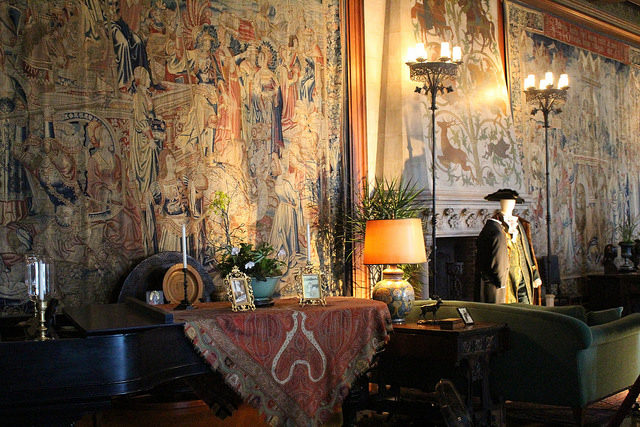The private Biltmore Estate is located near Asheville in North Carolina and is considered the largest home in the United States. The main residence is built in Chateau style. George Washington Vanderbilt II had the house built in only five years, between 1889 and 1895. Today, the estate is known as one of the most famous surviving examples of the Gilded Age.

Vanderbilt II, who was the youngest son of William Henry Vanderbilt, traveled many times to Asheville with his mother in the 1880s. He liked the climate and scenery so much that he decided to build his own house there. The name of the mansion, Biltmore, derives from his Vanderbilt ancestors’ original Dutch name “Bildt,” and “More,” which means “rolling land” in Anglo-Saxon.

Over 1,000 workers and 70 stonemasons were needed for the house alone. For this kind of project to be finished so quickly, factories for wood and brick were built onsite. In the meantime, Vanderbilt went overseas and bought thousands of furnishings for his new home, including linens, tapestries, decorations, carpets, prints, grand pianos, and rocking chairs.

The house was opened on Christmas Eve, 1895, and from that day on many of Vanderbilt’s family and friends came to his “little mountain escape.” Some of the notable guests who visited the mansion were the authors Henry James and Edith Wharton, Presidents Theodore Roosevelt and William McKinley, and the ambassadors Larz Anderson and Joseph Hodges Choate.

After a while, because of the newly imposed income taxes, Vanderbilt decided to sell 87,000 acres to the federal government. He died unexpectedly in 1914, and his wife Edith proceed with the sale, making sure the property became the center point of the Pisgah National Forest.
It was opened to the public in March 1930. The main reason for that was the difficult financial situation of Vanderbilt’s daughter Cornelia (then the house’s owner) and her husband during the Great Depression. During World War II, the property was closed, and the Music Room of the house was used as storage until 1944.

Inside, there were precious paintings by Raphael and Rembrandt, and portraits of George Washington painted by Gilbert Stuart. Cornelia divorced her husband Cecil in 1934 and left the estate for good. Their eldest son, George, occupied some of the rooms in the wing until 1956. From this point, the house was no longer a family residence and became a historic house museum. Today, it is one of the major tourist attractions in North Carolina. This remarkable estate was designated a National Historic Landmark in 1963.

The four-storey house has 250 rooms and many bathrooms and bedrooms for the Vanderbilt family and their friends. There are also three kitchens and electric elevators from the 19th century. The main rooms of the house are on the ground floor. The largest room inside is the Banquet Hall, which has a large table that could seat 64 guests and is surrounded by Flemish tapestries and a fireplace.
Other principal rooms on this floor are the marbled entrance hall, the organ gallery, the Music Room, the Tapestry Gallery, and the two-storey library.

The second floor can be accessed by the grand staircase, which spirals around a magnificent chandelier. On this floor are many of the bedrooms and the beautiful Damask Room, the Tyrolean Chimney Room, the Claude Room, the Louis XV Room—the biggest and most beautiful—which was restored and opened to the public on its 100th anniversary in 2011.

The guest rooms and the observatory are on the third floor, and the fourth floor has 21 bedrooms for the female servants. In the basement area, there is a swimming pool for the guests and a bowling alley. The kitchens are also there, as well as additional bedrooms for the other staff of the estate.
Today, the property covers 8,000 acres, which are split in half by the French Broad River. It is maintained by a trust set up by the family, the Biltmore Company.
